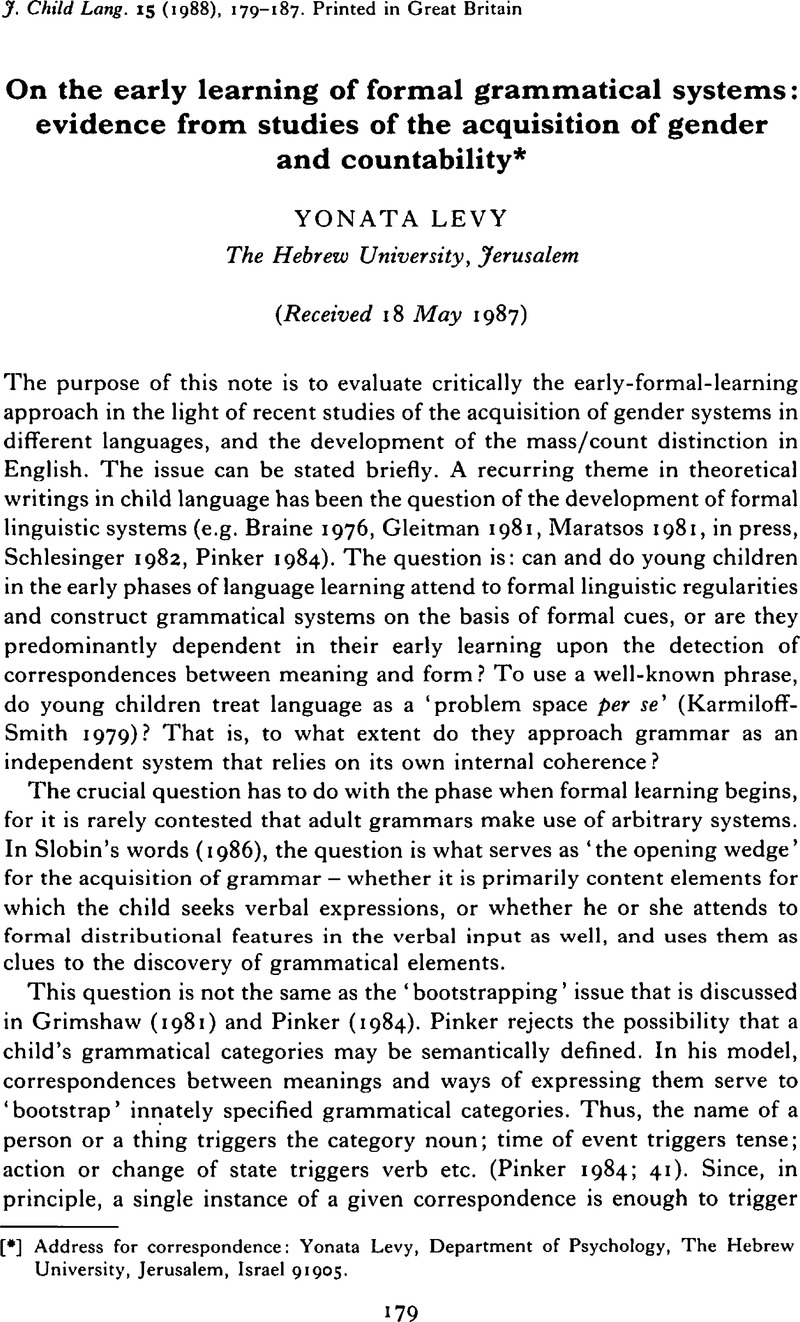Crossref Citations
This article has been cited by the following publications. This list is generated based on data provided by Crossref.
Pérez, Miguel
1990.
¿Cómo determinan los niños la concordancia de género?: Refutación de la teoría del género natural.
Infancia y Aprendizaje,
Vol. 13,
Issue. 50,
p.
73.
McPherson, Leslie Maggie Perrin
1991.
A little goes a long way: evidence for a perceptual basis of learning for the noun categories COUNT and Mass.
Journal of Child Language,
Vol. 18,
Issue. 2,
p.
315.
Pérez-Pereira, Miguel
1991.
The acquisition of gender: what Spanish children tell us.
Journal of Child Language,
Vol. 18,
Issue. 3,
p.
571.
Caselli, M. Cristina
Leonard, Laurence B.
Volterra, Virginia
and
Campagnoli, M. Grazia
1993.
Toward mastery of Italian morphology: a cross-sectional study.
Journal of Child Language,
Vol. 20,
Issue. 2,
p.
377.
Leonard, Laurence B.
Bortolini, Umberta
Caselli, M. Cristina
and
Sabbadini, Letizia
1993.
The use of articles by Italian-speaking children with specific language impairment.
Clinical Linguistics & Phonetics,
Vol. 7,
Issue. 1,
p.
19.
Bloom, Paul
1994.
Possible names: The role of syntax-semantics mappings in the acquisition of nominals.
Lingua,
Vol. 92,
Issue. ,
p.
297.
Soja, Nancy N.
1994.
Evidence for a distinct kind of noun.
Cognition,
Vol. 51,
Issue. 3,
p.
267.
Bloom, Paul
1996.
Perceptual and Cognitive Development.
p.
151.
Levy, Yonata
1996.
Morphology and syntax in the language of children with congenital brain pathologies a longitudinal follow up.
Journal of Reproductive and Infant Psychology,
Vol. 14,
Issue. 3,
p.
255.
Levy, Yonata
1997.
The development of morphology and syntax in a pair of DZ twin boys.
International Journal of Language & Communication Disorders,
Vol. 32,
Issue. 2,
p.
206.
Oliphant, Katrina
1998.
Acquisition of Grammatical Gender in Italian as a Foreign Language.
The Canadian Modern Language Review,
Vol. 54,
Issue. 2,
p.
239.
Levy, Y.
Tennenbaum, A.
and
Ornoy, A.
2000.
Spontaneous Language of Children With Specific Neurological Syndromes.
Journal of Speech, Language, and Hearing Research,
Vol. 43,
Issue. 2,
p.
351.
Burns, Tracey C.
and
Soja, Nancy N.
2000.
Children's acquisition of NP-type nouns: Evidence for semantic constraints on productivity.
Language and Cognitive Processes,
Vol. 15,
Issue. 1,
p.
45.
Levy, Yonata
and
Hermon, Shula
2003.
Morphological Abilities of Hebrew-Speaking Adolescents With Williams Syndrome.
Developmental Neuropsychology,
Vol. 23,
Issue. 1,
p.
59.
Colunga, Eliana
and
Smith, Linda B.
2005.
From the Lexicon to Expectations About Kinds: A Role for Associative Learning..
Psychological Review,
Vol. 112,
Issue. 2,
p.
347.
Weinert, Sabine
2009.
Implicit and explicit modes of learning: similarities and differences from a developmental perspective.
Linguistics,
Vol. 47,
Issue. 2,
Karniol, Rachel
2009.
Israeli kindergarten children's gender constancy for others' counter‐stereotypic toy play and appearance: the role of sibling gender and relative age.
Infant and Child Development,
Vol. 18,
Issue. 1,
p.
73.
ZESIGER, PASCAL
ZESIGER, LAURENCE CHILLIER
ARABATZI, MARINA
BARANZINI, LARA
CRONEL-OHAYON, STÉPHANY
FRANCK, JULIE
FRAUENFELDER, ULRICH HANS
HAMANN, CORNELIA
and
RIZZI, LUIGI
2010.
The acquisition of pronouns by French children: A parallel study of production and comprehension.
Applied Psycholinguistics,
Vol. 31,
Issue. 4,
p.
571.
Tager-Flusberg, H.
and
Seery, A.M.
2013.
Neural Circuit Development and Function in the Brain.
p.
315.
Boloh, Yves
and
Ibernon, Laure
2013.
Natural gender, phonological cues and the default grammatical gender in French children.
First Language,
Vol. 33,
Issue. 5,
p.
449.


